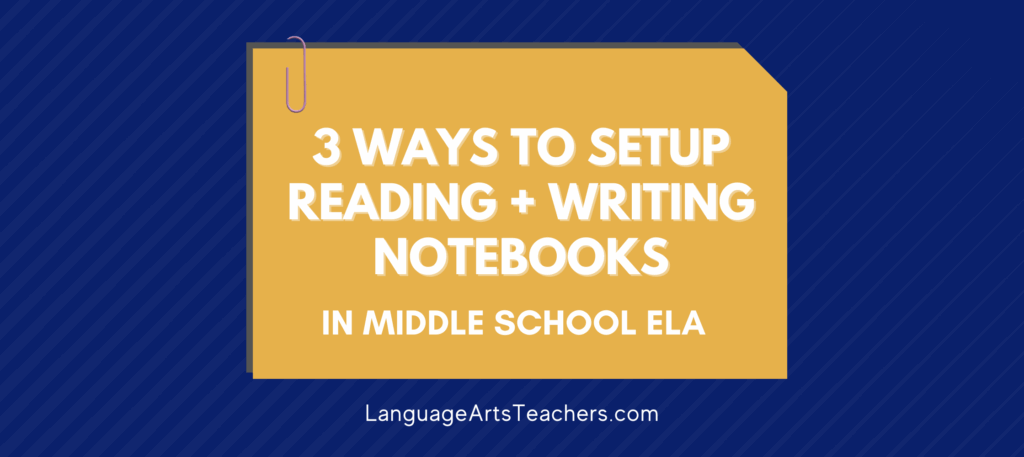Before we jump into the five methods, here’s the foundational thinking of each of the five strategies: Don’t grade every “thing” on every assignment. Choose one or two key focus areas to actually grade instead.
In fact, don’t grade every assignment, either! Sometimes a quick check mark, stamp, or verbal affirmation related to the assignment is plenty.
Finally, don’t take on guilt that you “should” be grading every single thing. Choose what you grade and how you grade it strategically so it benefits your students and doesn’t eat up your family time after school.
Now, onto my 5 most-often used grading / not grading methods (especially when it comes to writing):
- Think of different ways that students can show their mastery beyond typical paper/pen (or Google doc) assessments.
For example: Not every assignment must be an essay or even a short answer, and not every assignment even has to be written in full sentences (I know!! I’m breaking a major English teacher rule here!! It’s totally find to disagree!)
But, think about how there might be times that you could have your students show their learning through bullets or tick marks.
What if they could respond to what should be a “short answer paragraph” by simply writing the topic sentence, including a certain # of bullet points representing the content they would normally have in sentences, and then writing a concluding sentence (or not).
Wouldn’t it be so much easier to grade or assess that? This would NOT be the norm every time, but maybe every once in a while when you KNOW you just don’t have time to read even more written responses?
Plus, if you do have students respond this way several times in the course of a week, why not let them go back, choose the one they want, and then fully develop it into an actual paragraph that you do plan on grading?
They could still staple together/submit together all the work from the week with that full paragraph on top so you still only grade the one, but they got the learning and the experience from at least outlining the others.
- For writing assignments that you DON’T want to spend a ton of time grading, try this idea:
Create a very basic, simple, easy-to-understand rubric WITH your students in real-time.
An easy way to do that is to draw a grid-type chart on the board and number it 4 through 1. 4 can represent a 90 – 100. 3 could be 80 – 89. 2 could be 70 – 79, and 1 could be 60 and under. Or whatever number range because the point is that you set up a basic, easy way to score that your students also understand.
You can then determine which 1 or 2 main items (only 1 – 2) you’ll focus on. Get feedback from your students about what should represent each score.
Talk with them as a class about those 1 – 2 elements you will be assessing in the writing and have them talk to you about what exactly that looks like for each number (score) in that grid. Jot it down on the board as they talk to you or have a student volunteer write it down for you all.
Snap a photo with your phone, let the students do the same, and there you go– you just created a student-centered rubric specific to the writing lesson and you didn’t even have to type it up or spend time outside of class on it.
BONUS
This is a good time to have students assess their own work before turning it in to you. They can score their work, provide justification for the score, and that will make things so much easier for you as well as giving them ownership.
ONE MORE THING
Also have them justify why their score ISN’T one number lower. Example: Arman scores his work as a 3. He will justify the 3, but he also needs to justify why it’s better than a 2. Or explain what he needs help with next time to make it a 4.

- When you absolutely HAVE to grade every part of an assignment, it can help to grade one part at a time for EVERYONE.
Here’s what I mean:
Let’s say the assignment is three short answer responses (paragraphs) that students had to write and that this time, you really do need to read them all.
Instead of reading #1, #2, #3 PER student, read ALL the #1’s, then read ALL #2’s, then read ALL the #3’s.
Why
Because otherwise, your brain is constantly task-switching (aka “multitasking”) every time you go to the next kid’s page to read those answers.
When your brain only has to focus on #1 for a while, then #2 for a while, then #3… You get done sooner and you used less mental energy to do so.
BONUS: If something happens and you literally cannot get #3 graded, then hey, at least ALL your students will get their papers back with the same parts graded so you don’t have half the class’s done and the other half not done.
- Feeling frustrated about time spent jotting down (or typing) comments to students on their papers and then wondering (knowing?) they’ll never look at it?
But you also feel guilty if you don’t?
One way to get around this is to reduce your commentary to a symbol on their written responses and just provide students with a key.
For example:
= Solid commentary or solid text evidence
= Good start, but you need more
= I don’t understand what this is
Of course, symbols and keys can be created to mean whatever you need them to mean for your assignment. The above is just an example.
So a student gets his paper back and it has a few stars, a few exclamation marks, and a question mark.
When you have time in class, you could even have students pair up to help each other with their question marks / exclamation marks as a follow-up. Or, you could quickly gather a small group of students with question marks and run a mini-lesson to re-teach.
The point is that it all comes down to less grading at home on your own time, and more student involvement with their own work!
- During my time as a high school AP English teacher, I learned that AP Essay graders (for the 11th and 12th grade AP Language and AP Literature tests) only spend 30 – 60 seconds PER essay!!!!!!
One way they do this is by reading the thesis sentence, reading the topic sentences to ensure they support the thesis sentence, and then skimming for quality support.
They then make a FAST scoring decision and move on.
DONE and DONE!!
Think about it– Those AP essays are a major part of determining whether a high school student gets college credit or not. It’s a big deal > > Thousands of dollars and lots of time saved because of testing out of a class . . .
If it’s good enough for THAT, then it’s good enough for middle school.
Think about how you could adapt this way of thinking to make essays or short-answer questions easier and quicker to grade.
On that^ note, you don’t have to do this teaching thing alone. Join us for the one & only virtual test prep event to help Middle School Reading + Writing Teachers review for “The Test” without feeling like you’re actually reviewing.
Register for the FREE Test Prep Palooza event, or treat yourself with the upgraded Golden Ticket for early access to the sessions plus test review bonus lessons.




